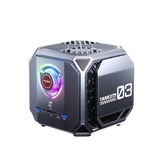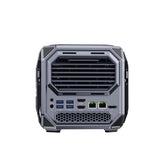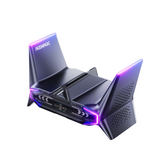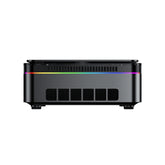Mechanical vs Membrane Keyboard: What’s the Main Difference?
In today's digital world, the keyboard is more than just a peripheral—it's a daily companion for work, play, and creativity. Whether you're coding, gaming, or drafting documents, the quality of your keyboard has a direct impact on your productivity and comfort. Among the most debated topics in the tech world is the showdown between mechanical and membrane keyboards.

This article aims to provide a complete, expert-backed comparison of these two keyboard types. By the end, you'll be well-equipped to select the keyboard that best suits your specific needs and preferences.
What is a Mechanical Keyboard?
A mechanical keyboard is a type of keyboard that uses individual mechanical switches for each key. These switches consist of several components, including a housing, a spring, and a stem. When a key is pressed, the stem moves downward and activates an electrical circuit, sending the keystroke to your computer.
Unlike membrane keyboards, mechanical switches do not rely on pressure pads to register input. This distinct construction allows for more precise keystrokes, tactile feedback, and a longer lifespan.
Key Components of a Mechanical Keyboard
Every mechanical keyboard is a combination of intricate parts that work harmoniously to deliver a reliable typing experience. The key components include:
- Switches: The core mechanism that determines how the key feels and sounds. Common types include Cherry MX, Gateron, and Kailh switches.
- Keycaps: Usually made from ABS or PBT plastic, keycaps sit atop the switches and affect the texture and aesthetic.
- PCB (Printed Circuit Board): The foundation where switches are mounted and signals are processed.
- Case and Plate: These provide structural support and influence the typing feel and acoustic performance.
Each of these parts plays a vital role in defining the mechanical keyboard's personality.

Types of Mechanical Switches
When people talk about mechanical keyboards, the discussion often starts with three main switch categories: linear, tactile, and clicky. Each provides a distinct typing experience and serves different user needs.
- Linear Switches (e.g., Cherry MX Red): These switches deliver a smooth keystroke from top to bottom with no tactile bump or audible click. They're ideal for gamers who require fast, uninterrupted input without feedback slowing them down.
- Tactile Switches (e.g., Cherry MX Brown): Tactile switches introduce a subtle bump at the actuation point. This feedback helps typists know exactly when a key has registered, enhancing typing accuracy without adding noise.
- Clicky Switches (e.g., Cherry MX Blue): These are tactile switches with an added click sound. That audible feedback is satisfying for many typists, but can be disruptive in shared environments.
While these three serve as the foundation, the modern mechanical keyboard market has expanded significantly. Today's users can choose from dozens of switch variants tailored to different preferences. There are heavy linear switches like Gateron Black, highly tactile options like Holy Panda, silent variants such as Cherry MX Silent Red, and even speed-focused switches like Kailh Speed Silver or Razer Optical Purple.
Each manufacturer—Cherry, Gateron, Kailh, Akko, Outemu, TTC, and others—tunes their switches differently, even if the naming appears similar. For instance, a Gateron Red often feels smoother than its Cherry counterpart, while Akko's tactile switches may offer a deeper bump with less travel.
Additionally, many enthusiast-focused brands now offer custom switches with unique spring weights, stem designs, and housing materials to deliver a refined typing or gaming experience. This diversity gives users the freedom to find a switch that perfectly matches their typing style, but it also means that choosing one can take a bit of trial and error.
If you're unsure where to start, it's best to begin with the classic red, brown, or blue switches and explore from there once you've identified your preferences.

What is a Membrane Keyboard?
A membrane keyboard uses a pressure pad system with three layers: a top membrane, a conductive trace, and a bottom membrane. When a key is pressed, it pushes the top membrane through a dome to connect with the bottom membrane, completing a circuit.
Unlike mechanical keyboards, membrane keyboards do not use individual switches for each key. This construction makes them more affordable and often quieter, though they tend to wear out faster and provide less tactile feedback.
Membrane Keyboard Construction
The typical membrane keyboard consists of:
- Rubber Dome Layer: Offers resistance and a "mushy" feel when typing.
- Top Layer Membrane: Contains the key characters and design.
- Conductive Trace Layer: Registers the key press when contact is made.
Because the keys are not separated by individual switches, key presses are usually softer but less precise, making them less ideal for high-speed typing or gaming.

Typical Usage Scenarios for Membrane Keyboards
Membrane keyboards are often used in budget laptops, public workstations, and home offices where the typing volume is moderate, and quiet operation is essential. Their affordability makes them a go-to choice for casual users and organizations outfitting multiple workstations.
Mechanical vs Membrane Keyboard: Key Differences
To truly grasp the value proposition of each keyboard type, we must compare them across several critical dimensions.
Typing Experience and Feedback
Mechanical keyboards offer a more satisfying and precise typing experience. Each keystroke provides clear feedback, reducing typing fatigue and errors. The tactile or clicky nature of certain switches is especially favored by writers, coders, and gamers.
In contrast, membrane keyboards lack this refined tactile response. The typing feel is often described as "mushy," which may not suit users who spend long hours at the keyboard or require rapid, accurate inputs.

Sound Levels and Noise Consideration
Sound is a major factor in keyboard selection. Mechanical keyboards—particularly those with blue switches—can be loud, which may disrupt shared environments. For quiet spaces, brown or red switches, or sound-dampening O-rings, can help reduce noise.
Membrane keyboards are generally quieter, making them better suited for shared offices, libraries, or environments where noise is discouraged.
Durability and Lifespan
Durability is one of the strongest advantages of mechanical keyboards. A single mechanical switch is rated for 50 to 100 million keystrokes, whereas a membrane keyboard typically lasts for 5 to 10 million keystrokes.
This massive difference means mechanical keyboards not only offer a better experience but are also a longer-term investment.
Maintenance and Repairability
Mechanical keyboards are modular. Many offer hot-swappable switches, meaning users can replace faulty switches without soldering. Keycaps can also be changed to suit aesthetics or ergonomics.
Membrane keyboards, on the other hand, are harder to repair. Once a rubber dome fails, the entire unit often needs replacing. This makes mechanical keyboards a better choice for those who value maintainability and customization.
Price Comparison
Membrane keyboards are undeniably budget-friendly, with prices starting as low as $10. They're ideal for basic tasks and non-intensive use.
Mechanical keyboards, however, range from $50 to $200 or more, depending on build quality, brand, and features. While the upfront cost is higher, their superior longevity and performance often justify the investment for serious users.
Gaming vs Office Use: Which Should You Choose?
Best Keyboard for Gamers
Gamers prefer mechanical keyboards due to their faster response time, n-key rollover (which allows multiple keys to register simultaneously), and tactile feedback. These features enhance gameplay precision, especially in competitive settings.
Switches like Cherry MX Red and Speed Silver are optimized for gaming, allowing rapid keystrokes without fatigue.
Best Keyboard for Typists and Writers
For professionals who spend hours writing, mechanical keyboards—particularly those with tactile switches like Cherry MX Brown—offer a comfortable, efficient typing experience. Membrane keyboards may suffice for light use but often fall short in terms of typing speed and comfort during long sessions.
Portability and Size Options
Beyond the feel of the keys and the inner workings of the switches, one often-overlooked yet crucial aspect of any keyboard is its size and layout. Portability isn't just about how light a keyboard is—it's also about how efficiently it uses space, how well it fits different setups, and how much functionality it retains when reduced in size.
Mechanical Keyboard Layouts: A Spectrum of Sizes
Mechanical keyboards are available in an impressively wide range of form factors. The most common is the full-size layout, which includes all standard keys: the alphanumeric section, function row, arrow cluster, and a dedicated number pad. While comprehensive, this layout can be bulky—often exceeding 440mm in width—which makes it less ideal for travel or minimalist desks.
For users seeking a balance between compactness and functionality, Tenkeyless (TKL) keyboards remove the number pad, slimming down the footprint without sacrificing core features. This layout is favored by gamers and office workers alike who don't frequently use the numpad but still need arrow keys and function buttons.
Stepping down even further, 75% and 65% layouts reorganize the keys into tighter clusters, reducing horizontal space while retaining essential navigation and editing keys. These layouts are especially popular among users with limited desk real estate or those who value a clean, efficient workspace.
At the ultra-portable end, 60% keyboards eliminate the function row, navigation keys, and numpad, relying on function layers to access those features. While minimal and highly portable, this layout demands more learning and muscle memory. There's also the niche but growing 40% layout, which strips the keyboard down to just the alphabet and a few modifiers—suitable only for advanced typists or hardcore enthusiasts.
Finally, split or ergonomic layouts—often used for posture improvement—also play a role in how "portable" a keyboard can be. Many of these can be folded or disassembled, making them practical for mobile professionals who prioritize health and portability equally.

Membrane Keyboards: Lighter, But Less Varied
Membrane keyboards are generally lighter and thinner due to their simpler internal structure. Many mass-market variants are designed as part of laptop-style builds or integrated into ultra-slim casings. However, while they're easy to carry, they often come in fixed, full-size configurations with little regard for desk space efficiency.
Portability in membrane keyboards is often a byproduct of cost-cutting, not thoughtful design. They may be light and cheap to replace, but they rarely offer the same typing feel, ergonomic consideration, or build quality seen in well-designed compact mechanical keyboards.
Choosing the Right Size for Your Lifestyle
If you're constantly on the move, a 60% mechanical keyboard offers an unbeatable balance of compactness and functionality. It slips easily into a backpack, can be paired with laptops or tablets, and often comes with wireless connectivity to cut cable clutter.
For hybrid workers or those who occasionally travel but still need dedicated arrow keys and Delete/Home/End functions, a 65% or 75% layout might be the sweet spot. These provide just enough utility without overwhelming your workspace.
Meanwhile, if you never leave your desk or you rely on Excel and heavy data input, a full-size mechanical or membrane keyboard may be worth the desk space for the convenience of a numpad.
It's also worth noting that many mechanical keyboards today offer hot-swappable PCBs and detachable cables, which improves portability even further. Some foldable or modular split designs go even further, letting users tailor their setup to specific workflows while remaining travel-friendly.
Aesthetics and Customization
Mechanical keyboards lead in customization. Enthusiasts can swap out keycaps, change switches, install custom lighting, and even program macros. This makes mechanical keyboards not just a tool, but a personalized extension of the user's style and workflow.
Membrane keyboards usually have limited customization options. While some offer basic RGB lighting, the design and features are largely fixed.
Pros and Cons Summary Table
| Aspect | Mechanical Keyboard | Membrane Keyboard |
|---|---|---|
| Typing Feel | Precise, tactile or clicky | Soft, "mushy" |
| Durability | 50M–100M keystrokes | 5M–10M keystrokes |
| Noise | Varies by switch, can be loud | Generally quiet |
| Price Range | $50–$200+ | $10–$50 |
| Customization | Extensive (keycaps, switches, lighting) | Limited |
| Repairability | Easy (modular components) | Difficult |
| Portability | Heavier, multiple sizes | Lightweight, fewer size options |
| Best For | Gaming, heavy typing | Basic office work, casual use |
Pairing Keyboards with Mini PCs: Why the Right Choice Matters
Mini PCs are all about maximizing performance in minimal space, and your choice of keyboard can significantly influence that experience. Since many Mini PC setups aim for portability, compactness, or clutter-free workstations, the type of keyboard you choose should align with those priorities.
Mechanical keyboards, especially in 60% or 65% layouts, pair exceptionally well with Mini PCs. These smaller mechanical boards offer full functionality through layers while preserving valuable desk space. Their robust build and wireless options (such as Bluetooth or 2.4GHz connectivity) make them ideal companions for mobile or modular Mini PC setups—whether you're coding on the go, managing a home server, or playing lightweight games in the living room.
On the other hand, membrane keyboards—being slimmer and more affordable—are often bundled with compact desktop kits or used for more casual environments. They connect quickly, consume minimal power, and are sufficient for light browsing or office work when paired with a Mini PC.
Ultimately, if your Mini PC is more than just a plug-and-play station—if it's your daily driver, workstation, or gaming cube—a mechanical keyboard may provide the tactile satisfaction, responsiveness, and durability to match the performance-focused design ethos of a Mini PC.

Expert Recommendations
Choosing between a mechanical and a membrane keyboard depends on your personal preferences and usage habits. If you're a gamer, programmer, or writer who spends hours typing, a mechanical keyboard is a worthwhile investment. Its durability, typing feel, and customization are unmatched.
However, if you're on a tight budget, prefer quiet operation, or only use your keyboard occasionally, a membrane keyboard might serve you well without breaking the bank.
FAQs about Mechanical vs Membrane Keyboards
1. What is the biggest difference between mechanical and membrane keyboards?
Mechanical keyboards use individual switches under each key for precise and tactile input, while membrane keyboards rely on a pressure pad system, making them quieter but generally less responsive.
2. Which type of keyboard is better for gaming?
Most gamers prefer mechanical keyboards due to their faster actuation, n-key rollover support, and tactile feedback, which enhance accuracy and control during gameplay.
3. Are mechanical keyboards always louder than membrane keyboards?
Not always, but typically yes. Mechanical keyboards—especially clicky switch types—produce more noise, while membrane keyboards offer a quieter, softer sound. Silent switches can reduce noise in mechanical models.
4. Do mechanical keyboards last longer than membrane ones?
Yes. Mechanical keyboards are built to withstand 50–100 million keystrokes per switch, far surpassing the 5–10 million keystrokes typically supported by membrane keyboards.
5. Can I change the keycaps or switches on a mechanical keyboard?
Yes. Most mechanical keyboards support keycap replacement, and many newer models also offer hot-swappable switches, letting you customize both look and feel without soldering.
6. Are membrane keyboards more portable than mechanical keyboards?
Generally, yes. Membrane keyboards are thinner and lighter, making them more convenient for travel. However, compact mechanical keyboards (like 60% or 65%) are now competing closely in portability.
7. Is there a mechanical switch that feels like a membrane keyboard?
Some linear switches, like Cherry MX Red or Gateron Yellow, offer a soft, smooth keystroke that feels closer to membrane keyboards, but with better responsiveness and durability.
8. Can I use either keyboard type with laptops, mini pcs, tablets, and or consoles?
Yes. Both mechanical and membrane keyboards with USB or Bluetooth can connect to laptops, mini pcs, and tablets. Mechanical keyboards can also work with consoles like PS4 or Xbox, though functionality may be limited in games.
9. Are membrane keyboards better in environments where silence matters?
Absolutely. Because of their quieter rubber dome design, membrane keyboards are ideal for offices, classrooms, or shared workspaces where low noise is preferred.
10. Can a membrane keyboard still be good for gaming or programming?
While mechanical keyboards are often favored for their speed and precision, membrane keyboards can still handle casual gaming or basic programming, especially if you prioritize budget and quiet operation.
Conclusion: Which One is Right for You?
The battle of mechanical vs membrane keyboard ultimately comes down to how and why you use your keyboard. If performance, customization, and durability are top priorities, go mechanical. If affordability and simplicity are more important, a membrane keyboard could be your best bet.








Leave a comment
Please note, comments need to be approved before they are published.